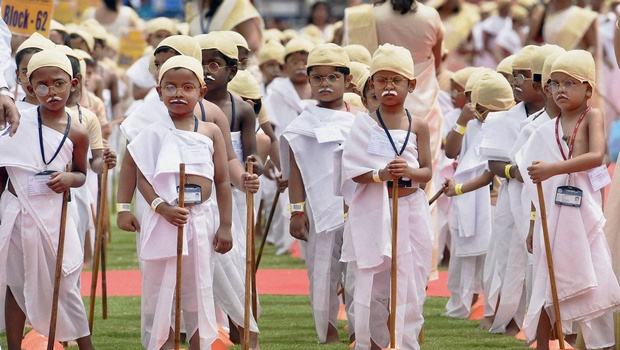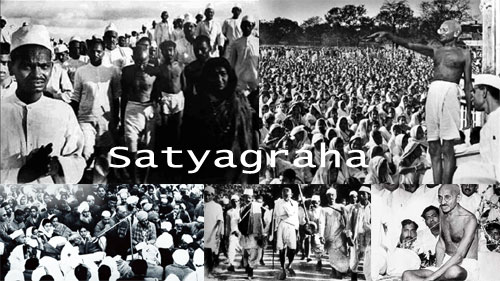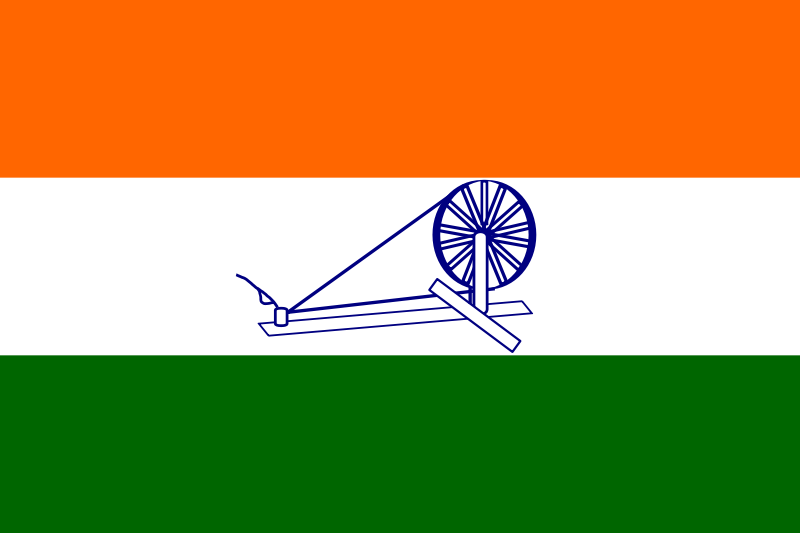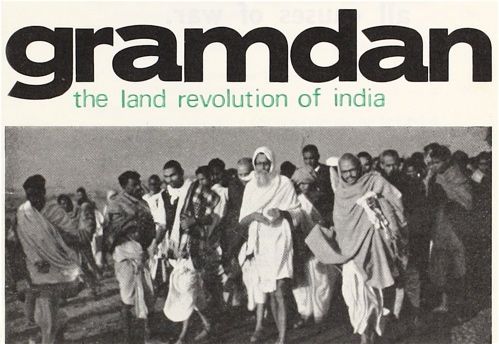Author Archive: Devi Prasad
DEVI PRASAD (1921-2011) was a studio potter, peace activist, artist,
and in the 1960s and 70s acting director of War Resisters'
International (WRI). As a child he was educated at Rabindranath
Tagore's school, Shantiniketam, and in 1944 Gandhi invited him to his
ashram at Sevagram to teach pottery. Besides spinning cotton and
weaving cloth (khadi), the most famous of Gandhi's methods of
self-sufficiency, Gandhi also valued and encouraged all the crafts,
and insisted they be included in the curriculum of his ashram schools.
by Devi Prasad

Schoolchildren dressing as Gandhi to commemorate his 146th birthday; courtesy newindianexpress.com
Editor’s Preface: This previously unpublished essay by Devi Prasad is another in our series from the IISG archive, Amsterdam. It is well to bear in mind that Prasad lived as a child at Tagore’s school, discussed in the article, and that he was later asked by Gandhi to teach in one of his ashrams. His knowledge of Gandhi’s education system, therefore, was uniquely first-hand. Please consult the notes at the end for archival reference, acknowledgments, and biographical information. JG
At the centre of Gandhi’s many concerns about social and political issues, there are two things that remained consistently predominant throughout his life. Firstly, a revolt against the education system that was given to, nay, imposed upon India by the colonial rule; and secondly, a powerful urge to find an appropriate approach and method of imparting education to all the children and adults of the country.
Read the rest of this article »
by Devi Prasad

Gandhian civil resistance poster; courtesy peacetopia.com
To begin with I shall discuss some of the commonly used terms in connection with nonviolent action against oppression, and which are often mistakenly understood to be the same as the Satyagraha practiced and advocated by Gandhi. This is to try to point out the differences between the concepts these terms represent and how they are not quite the same as the concept of Satyagraha. These terms are passive resistance, non-cooperation, direct action, civil disobedience and non-resistance. My aim is not to minimise, even to the slightest degree, the merits, uses and strength of these methods, but to point out that in contrast to any of them Satyagraha is a complete philosophy, as well as the technique of fundamental social change. Whereas the philosophy of Satyagraha implies a holistic approach to both long term as well as immediate issues facing humankind, the practice of the above-mentioned concepts is, by definition, limited to particular situations without being necessarily related to other social or political problems.
Read the rest of this article »
by Devi Prasad

Gandhi’s “Swaraj Flag”, 1931; courtesy en.wikipedia.org/wiki/Flag_of_India
Mahatma Gandhi’s concept of freedom is illustrated by that statement in which he clearly said that India would truly be free when freedom reaches the door of the most dilapidated hut in the poorest village of the country. He said that when the British leave the country, swaraj (freedom) will of course reach New Delhi, but until it goes to every hut, and every village feels freedom (swaraj) in his own life, it will not be of much meaning. What he meant was that until the common man of India lives a life of dignity and fearlessness, India will not achieve the freedom of his concept. He once stated: ‘One sometimes hears it said: “Let us get the Government of India in our own hands and everything will be all right.” There could not be greater superstition than this. No nation has thus gained its independence. The splendour of the spring is reflected in every tree, the whole earth is then filled with the freshness of youth. Similarly, when the swaraj spirit has really permeated society, a stranger suddenly come upon us will observe energy in every walk of life . . . Swaraj for me means freedom for the meanest of our countrymen. I am not interested in freeing India merely from the English yoke. I am bent upon freeing India from any yoke whatsoever.’ At another occasion he said: ‘Self-government means continuous effort to be independent of government control whether it is foreign government or whether it is national.’
Read the rest of this article »
by Devi Prasad

Cover of Gramdan brochure; courtesy WRI/London
Editor’s Preface: This article is the introduction to a special brochure published by WRI in 1969, Gramdan: The Land Revolution of India. We are posting under this date several essays from this publication. Although definitions of Gramdan and Bhoodan are given in some of the texts it might be handy to note here that Gramdan referred to a landowner’s donation of title of parcels of his land to the poor, while Bhoodan was communal or shared ownership by a village of donated land. Please also consult the Glossary at the end of each article. Further notes about authors, etc, are also found at the ends of articles. JG
The Gramdan Movement is not very well known outside India. There are people who have visited Gramdan areas, met some Sarvodaya workers and even worked in the Movement for sometime. Some of them have been impressed by the philosophy behind it and even consider it realistic but have been disappointed by the actual achievements of the Movement. Some think it to be purely Utopian. There are others who are moved by the humanitarian aspect, but who fail to grasp the political and social revolutionary elements. Very few people have yet been able to see Gramdan—the land revolution, as I would like to call it—in its totality, within the context of what is happening, and what is not happening, all over the world at the present time.
Read the rest of this article »








